We put the Apple iPhone 13 Pro Max through our rigorous DXOMARK Display test suite to measure its performance across six criteria. In this test results, we will break down how it fared in a variety of tests and several common use cases.
Overview
Key display specifications:
- 6.7‑inch OLED display
- Dimensions: 6.33 x 3.07 x 0.30 inches (160.8 x 78.1 x 7.65 mm)
- Resolution: 2778 x 1284 (~458 ppi)
- 1000 nits max brightness (typical); 1200 nits max brightness (HDR)
- Aspect ratio: 19.5:9
- ProMotion technology with adaptive refresh rates up to 120 Hz
- Chipset: A15 Bionic
Scoring
Sub-scores and attributes included in the calculations of the global score.
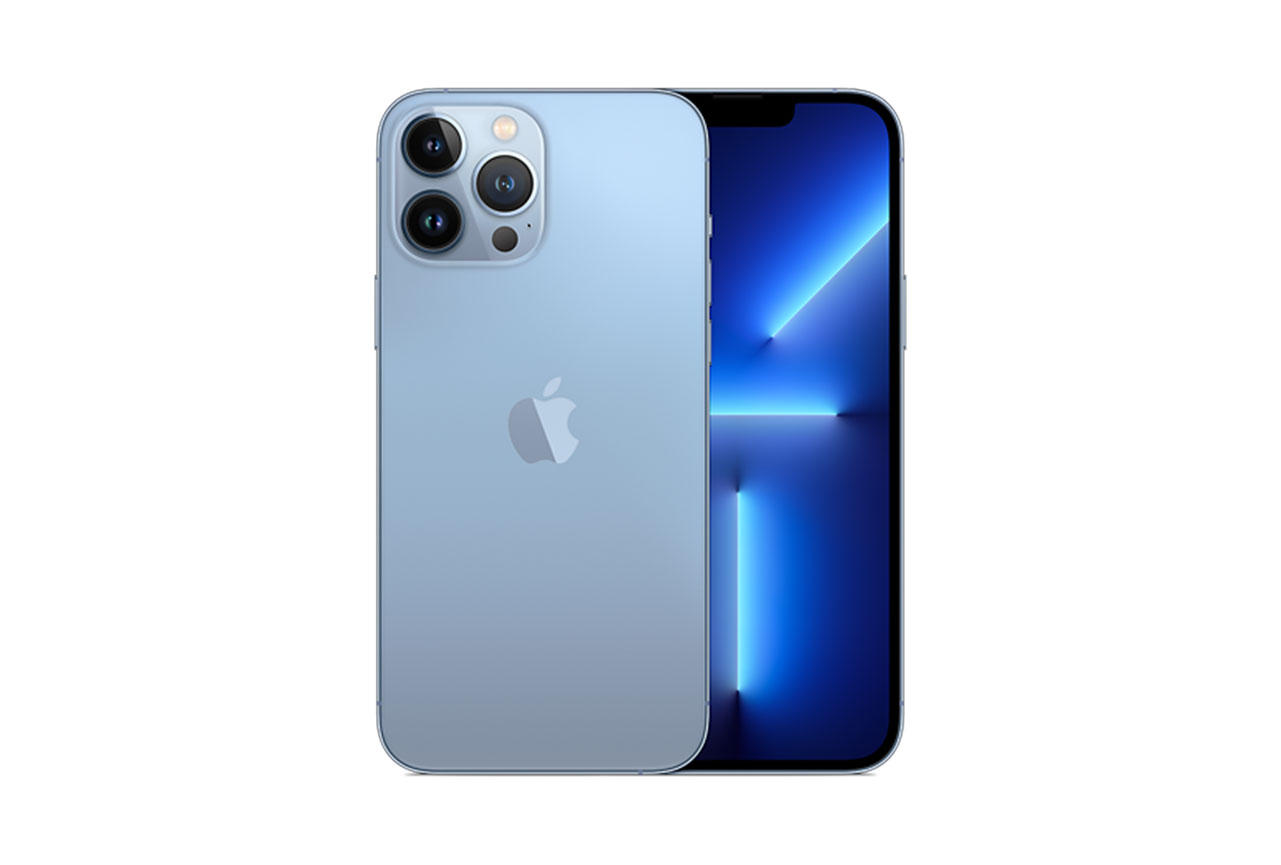 Apple iPhone 13 Pro Max
Apple iPhone 13 Pro Max


 8th
8th
 7th
7th
Pros
- Excellent readability in nearly all conditions.
- Excellent color fidelity, including when viewed at an angle.
- Device is reactive and smooth when browsing.
- Very pleasant HDR10 video experience with the right brightness, contrast, and color fidelity.
- Excellent control of artifacts.
Cons
- Device is not bright enough at its default settings for comfortable night reading.
- Display has a strong orange cast when the blue light filter is on.
- Device could be smoother when gaming.
The Apple iPhone13 Pro Max test results clearly demonstrate major improvements over the iPhone 12 Pro Max in several key areas of display performance. But above all, the screen’s exceptionally smooth adaptation to changing lighting conditions in all use cases means that users will have a consistently pleasant viewing experience in terms of brightness, contrast, and color. The iPhone 13 Pro Max might not have the highest level of brightness when compared with its competitors, but the device more than makes up for this with its fine-tuned and excellent rendering of content.
Test summary
About DXOMARK Display tests: For scoring and analysis in our smartphone and other display reviews, DXOMARK engineers perform a variety of objective and perceptual tests under controlled lab and real-life conditions. Note that we evaluate display attributes using only the device’s built-in display hardware and its still image (gallery) and video apps at their default settings. (For in-depth information about how we evaluate smartphone and other displays, check out our articles, “How DXOMARK tests display quality” and “A closer look at DXOMARK Display testing.”
The following section gathers key elements of our exhaustive tests and analyses performed in DXOMARK laboratories. Detailed performance evaluations under the form of reports are available upon request. Do not hesitate to contact us.
Readability
Apple iPhone 13 Pro Max
160
Readability evaluates how easily and comfortably users can read still content (photos & web) on the display under different real-life conditions. DXOMARK uses its Display Bench to recreate ambient light conditions ranging from total darkness to bright sunlight. In addition to laboratory tests, perceptual analysis is also made in real-life environments.
The Apple iPhone 13 Pro Max achieves a new top score for readability, with better brightness than its predecessor and better rendering than the OnePlus and Samsung devices.
Interestingly, the iPhone devices have the capacity to display photos taken with iPhone (HEIC files) as HDR content. With an increased peak brightness (1180 nits measured for the 13 Pro Max vs. 1100 nits for the 12 Pro Max), the 13 Pro Max can render the very bright tones in photos even better. This extended dynamic range produces a flattering effect most of the time, although we have noticed an unnatural look in certain cases. None of the tested competitors delivers this HDR rendering feature.
Overall readability is outstanding both indoors and outdoors. In indoor conditions (as in the illustration below), the Samsung Galaxy S21 Ultra 5G (Snapdragon) is brighter but shows fewer details in the hair than the iPhone 13 Pro Max, which provides the most faithful image rendering.

The Apple iPhone 13 Pro Max is very readable under sunlight, all while maintaining a natural-looking color rendering. The 13 Pro Max shows great improvement over the 12 Pro Max in brightness, but also when it comes to visibility of details in dark areas. Note that in the illustration below, the Samsung image appears brighter than the 13 Pro Max image (1379 nits measured on the Samsung and 1066 nits measured on the iPhone), but our engineers found that after a few minutes in sunlight, the S21 Ultra 5G (Snapdragon) would tamp down its brightness, presumably to keep from overheating. The 13 Pro Max did not have any issues in similar conditions and maintained its brightness.

The Apple iPhone 13 Pro Max adapts its brightness very smoothly to changing lighting conditions. At its default settings, however, the device is still too dark when reading at night (blue light filter off):

Color
Apple iPhone 13 Pro Max
163
The color attribute evaluates the capacity of the device to accurately reproduce colors. The measurements taken are for fidelity, white point color, and gamut coverage. We perform color evaluations for different lighting conditions to see how well the device can manage color in the surrounding environment. Colors are measured using a spectrophotometer in a controlled lighting environment. Perceptual analysis of color rendering is against the reference pattern displayed on a calibrated professional monitor.
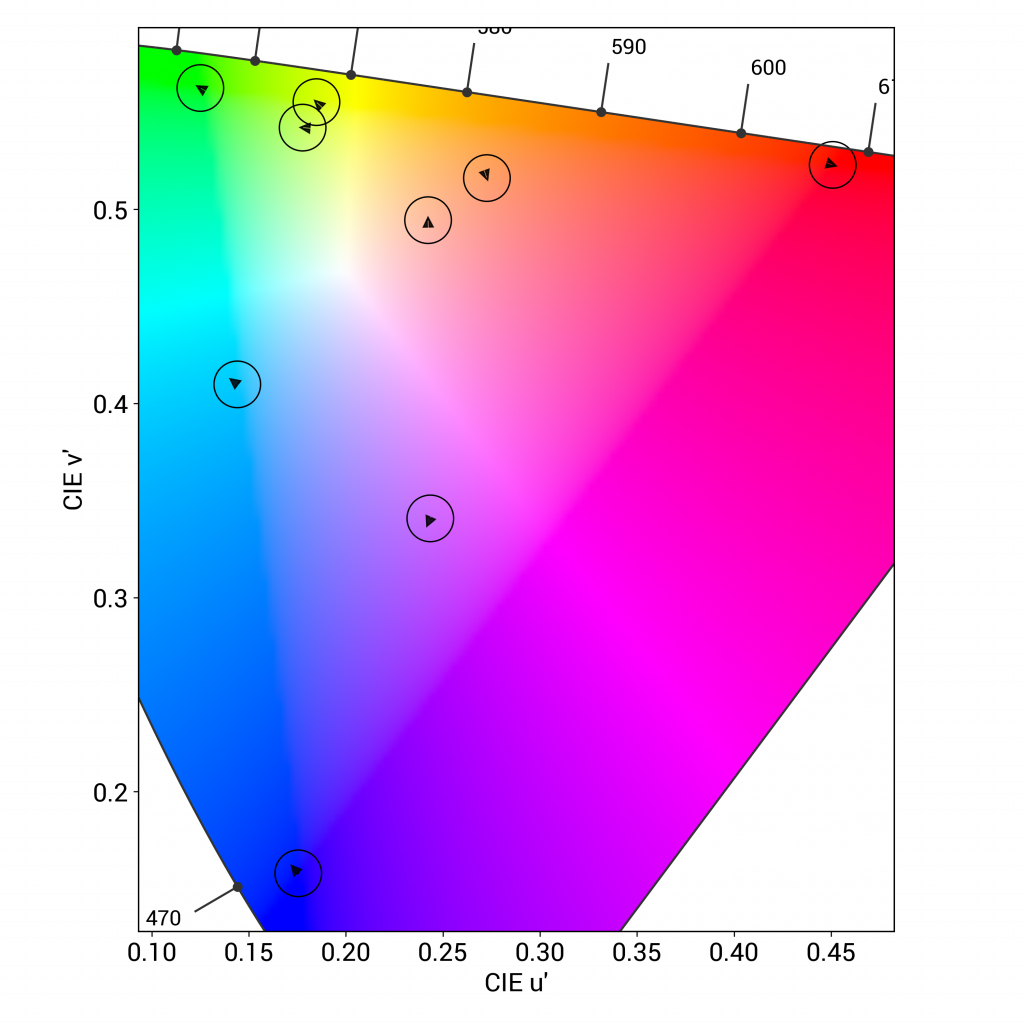

The iPhone 13 Pro Max adapts its white point to lighting conditions. It has good color fidelity, and it is much less yellow than the iPhone 12 Pro Max overall. In the example below, the Samsung image is clearly oversaturated.

Although the iPhone 13 Pro Max has a slight green cast outdoors, it is still more accurate and pleasant than the Samsung Galaxy S21 Ultra 5G (Snapdragon), which is too saturated and orange.
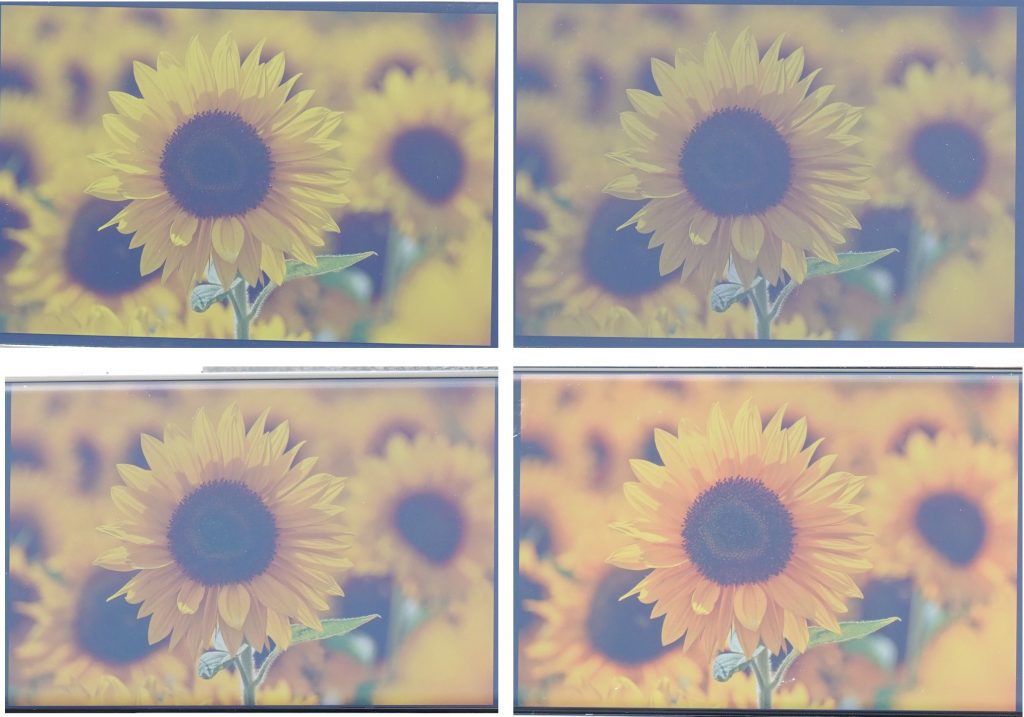
The Apple iPhone 13 Pro Max shows no major color changes when held on angle, which is again a great improvement over its predecessor. On angle, the iPhone 13 Pro Max keeps its colors, while the iPhone 12 Pro Max turns green, and the Samsung Galaxy S21 Ultra 5G (Snapdragon) turns very blue.




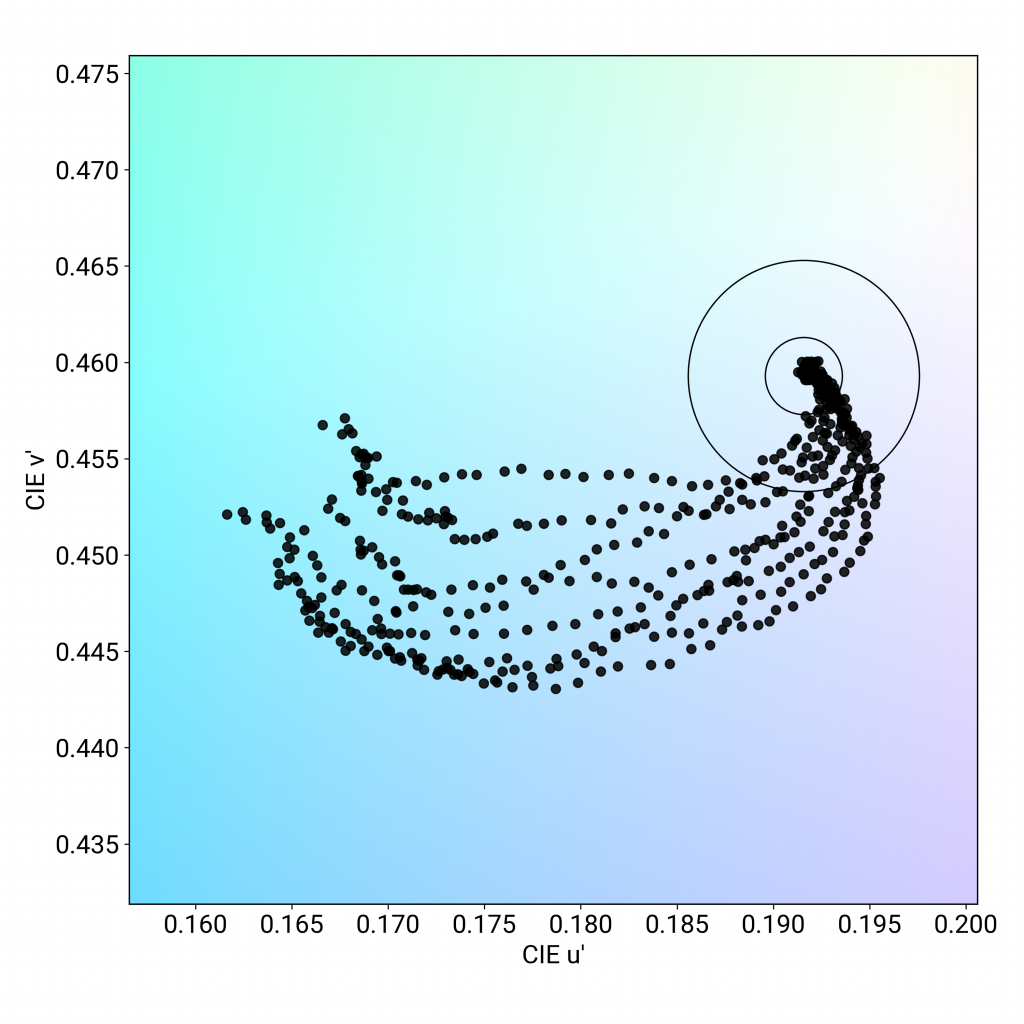
But while its overall color rendering is much improved over the 12 Pro Max, the iPhone 13 Pro Max still has the same very noticeable orange cast with the blue light filter on as the 12 Pro Max.
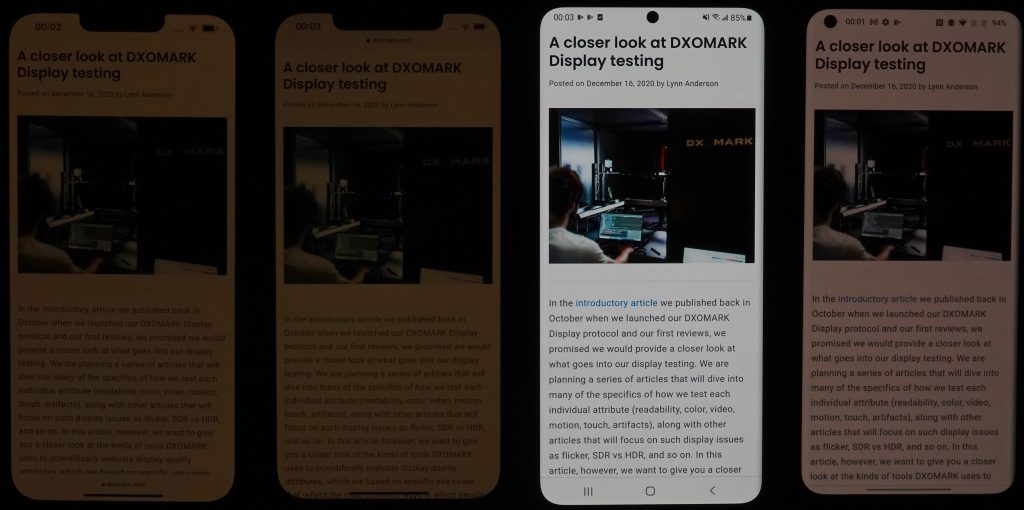
Video
Apple iPhone 13 Pro Max
162
Our video attribute evaluates the Standard Dynamic Range (SDR) and High Dynamic Range (HDR10) video handling of each device in indoor and low-light conditions. We measure tone mapping, color gamut, brightness and contrast of the display. We perform perceptual analysis against our professional reference monitor (Sony BVM-HX310) to ensure that the rendering respects the artistic intent.
The Apple iPhone 13 Pro Max is very good for watching HDR10 videos. There are no frame drops nor judder, and its HDR rendering is outstanding. Further, it has a wider dynamic range and good brightness, and does a better job with contrast and tone mapping than the 12 Pro Max.

In low-light conditions, the iPhone 13 Pro Max is significantly dimmer than the Samsung Galaxy S21 Ultra 5G (Snapdragon) when playing SDR content, and Apple users may want to manually increase brightness:

The iPhone 13 Pro Max’s video colors are faithful, especially compared to the 12 Pro Max, which has a visibly yellow cast. When judged against the test reference photo, the colors on both the 13 Pro Max and the Samsung land just on either side, with the 13 Pro Max on the warmer side and the Samsung appearing somewhat cooler.
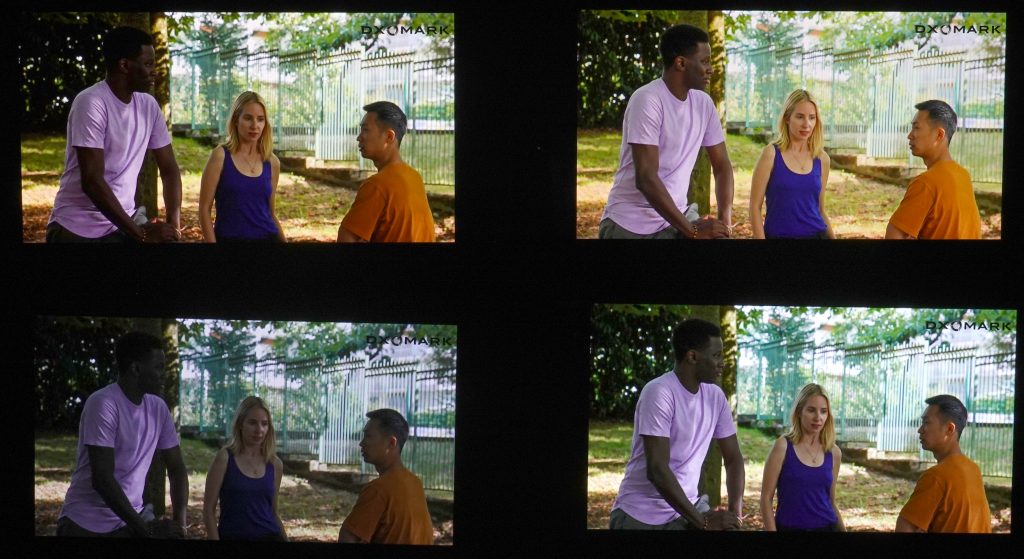
Motion
Apple iPhone 13 Pro Max
155
The motion attribute evaluates the handling of dynamic contents. Frame drops, motion blur, and playback artifacts are scrutinized using games and videos.
The Apple iPhone 13 Pro Max shows no frame drops nor stutters when playing videos, unlike the 12 Pro Max, the S21 Ultra 5G (Snapdragon), and the OnePlus 9 Pro. Further, the iPhone 13 Pro Max has no judder at 24, 30, and 60 fps videos, which is also true of the Samsung device. In order to show a 24 fps video on a 60 Hz display, such as on the iPhone 12 Pro Max, the device needs to perform a 3:2 pulldown as illustrated in the photo below.
Moving objects appear sharp in videos. The device is reactive when jumping backwards or forwards in videos; however, in some cases there can be some blocking or some pixelating artifacts, but this behavior is quite rare.
When gaming, our testers experienced no frame drops with the iPhone 13 Pro Max, although some were visible on the 12 Pro Max and the S21 Ultra 5G (Snapdragon).


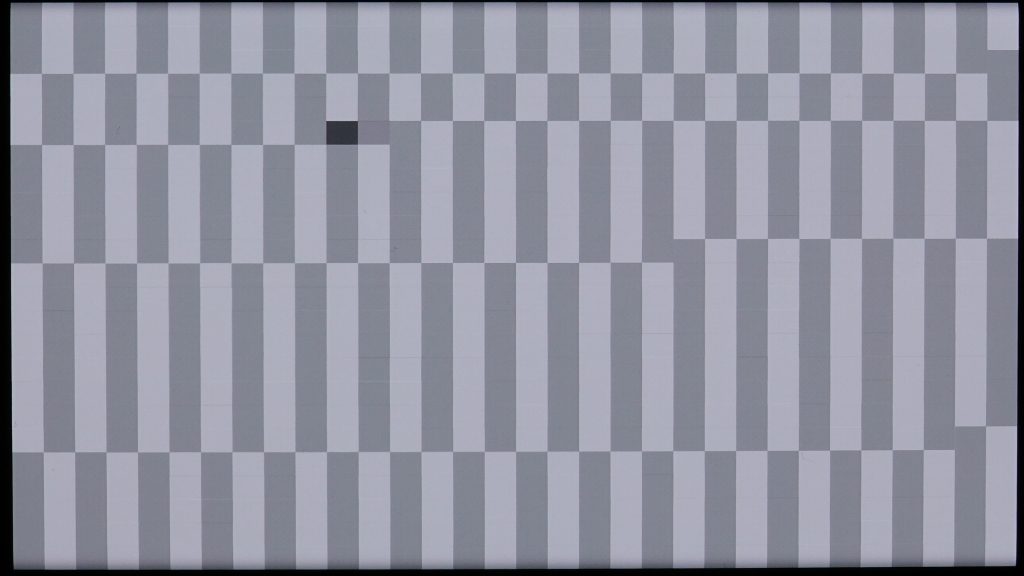
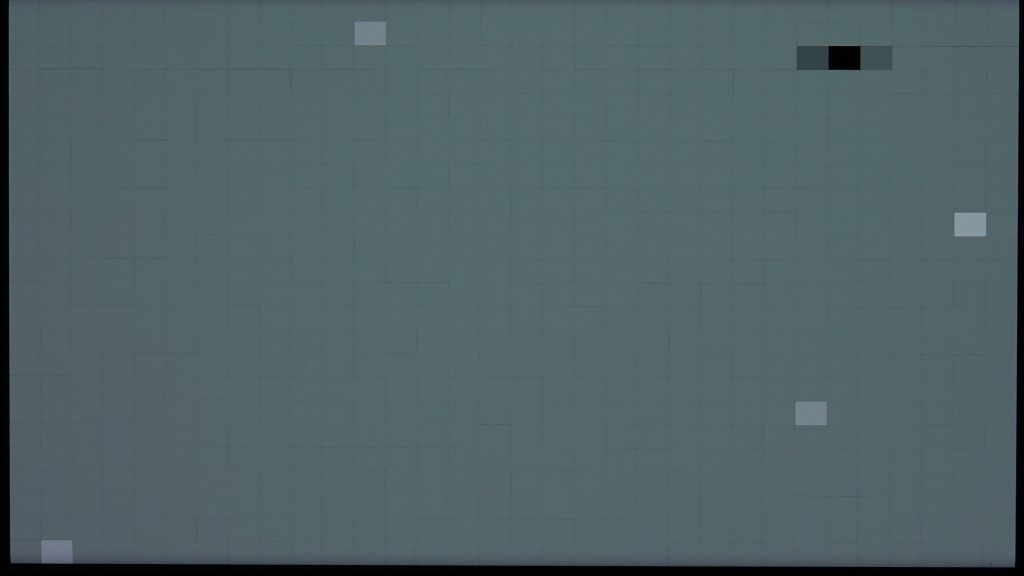
Touch
Apple iPhone 13 Pro Max
165
To evaluate touch, DXOMARK uses a touch robot and a high-speed camera to play and record a set of scenarios for smoothness, accuracy and response-time evaluation.
Touch on the iPhone 13 Pro Max is accurate and very smooth in the gallery app, when browsing the web, and in general use (switching apps, navigating within the phone, etc.). It is indeed smoother than the iPhone 12 Pro Max in those cases, thus showing the benefits of its adaptive 120 Hz refresh rate, but the 13 Pro Max shows no improvement when it comes to smoothness when gaming.
Artifacts
Apple iPhone 13 Pro Max
158
Evaluating artifacts means checking for the performance, image rendering and motion flaws that can affect the end-user experience. DXOMARK measures precisely the device’s reflectance and the presence of flicker, and assesses the impact of residual aliasing when playing video games, among other characteristics.
The Apple iPhone 13 Pro Max shows excellent control of artifacts. It does not respond to ghost touches, and it manages flicker well. In fact, both the Samsung device and the iPhone 12 Pro Max have noticeable flicker at intervals of 240 Hz in the video below. The iPhone 13 Pro Max and the iPhone 13 flicker at twice the speed of the other devices (that is, at 480 Hz), which makes flicker on these most recent Apple devices less noticeable.
Looking at the iPhone 13 Pro Max’s bright stripes, however, one is bright (and quite white) and the next one is less bright (and pinkish as well), creating an alternating pattern of bright stripes and darker stripes. The net visual effect for some users may result in a prolongation of the dark zone, making flicker a bit more visible on the iPhone 13 Pro Max than on the iPhone 13.
Even though the iPhone 13 Pro Max’s notch is smaller than the one on the 12 Pro Max, the screen-to-body ratio remains smaller than that of its competitors.
The Apple iPhone 13 Pro Max shows improvement over the iPhone 12 Pro Max and does a decidedly better job of handling aliasing than the Samsung Galaxy S21 Ultra 5G (Snapdragon), as illustrated below.






DXOMARK invites our readership (you) to post comments on the articles on this website. Read more about our Comment Policy.